.
...
PEGGY McDONOUGH & JULIO BERMUDEZ
...
Published in: Proceedings of the 13th. National Conference on the Beginning Design Student. Baton Rouge, LA: Lousiana State University (1996)
© copyright 1996 Peggy McDonough & Julio Bermudez. All rights reserved
...
Although much has been said about the direct relationship between art and architecture, little has been done regarding how historically significant works of art may be utilized as sources of inspiration for the architectural production of today. We may cite several historical and aesthetic analyses on such works of art and their particular zeitgeist, but how might such a work of art illuminate and extend today's architectural process, theories and ideas?
In other words, (1) how does the past (in)(de)(re)form the present? and (2) how do another discipline's insights (in)(de)(re)form our discipline's process of ideation? Having these thoughts in mind, a pedagogy was developed to make students realize that (1) architecture deals with issues and ideas that transcend the purely programmatic (i.e., 'functional') and the stereotypically formal; (2) new architectural ideas may come from old and non-architectural sources; (3) ideas are discovered and evolve through a staged critical process, as opposed to a singular act of explanation ; and (4) the role of the architect/designer is one of interpreter, as opposed to imitator, of one's surroundings, culture, tradition, etc.
...
...
The strong relationship between art and architecture has been largely documented. An excellent argument in this matter is advanced by Colin Rowe and Robert Slutzky in their article Transparency: Literal & Phenomenal .[*1 In this work, Rowe & Slutzky demonstrate the intensive dialogue between cubist painting and modern architecture, focusing particularly on the aesthetic/technical aspects of transparency and the Cubist phenomenon of simultaneity.[*2] This inquiry looks at how art can inform architecture, and, in turn, how architecture can heighten one's experience of art. Similar findings may be found with respect to almost any period in human history.[*3]
Our interest here, however, is not in the re-action of previously expounded upon historical parallels between art and architecture. It is, rather, that given art and architecture's strong symbiotic relationship, one could consciously use art (painting for the purposes of this discussion) as a catalyst for new architectural ideation. Utilizing art as a means to extend architectural inquiry would obviously require a metaphoric or analogic leap between the particular issues that the work of art had to confront, and those that architecture faces today. It is precisely this leap (whose potentially transcends the purely aesthetic, and moves into the technical, philosophical, social, or political)that is exciting: the art piece becomes an instrument for shifting our ordinary perception in order to see architecture in a new light.
...
Unlike other design methodologies which engage an exemplar or model, as in the use of architectural typology for example, this approach could offer far more removed, and therefore more open-ended ways to access new architectural ideas. In the ongoing discussion about the value of the architectural precedent as informer to the design process, we consider the temptation on the part of the student to literally appropriate, or repeat "masterpieces", in an attempt to give value to the new.
"Type pushes architecture into imitations of linguistic models in which meaning ultimately lies outside the work itself. A priori abstractions or typical 'elements' (walls, columns, rooms, plans, etc.) have priority over the things themselves. Creative design becomes a process of matching or compliance rather than making or constructing." [*4]
Although painting, as a cultural work, could also lend itself to being typed, it doesn't lend itself to be taken literally when asked to be applied to another discipline. Thus, the student is forced to delve beyond the surface, develop interpretation skills, and apply translated relevancies to their own pursuit: that of architecture.
It is not the purpose of this paper to imply that the painting, or art in general, as a model should be utilized in place of the architectural model in the design studio. However, one must consider the possible effects if the painting as model is used preceding, or in conjunction with the use of architectural models in a beginning design studio. In such a case, the act of interpretation would become clearly emphasized over the act of imitation.
True art and architecture never come out of repeating the existing versions of reality, usually inherited from the past and projected onto conscious existence as ordinary habits of perceptions or actions. Rather, it is the intentional or proactive seeing/doing of something not yet seen/done that manages to reveal itself as relevant to the existing cultural milieu. This requires a value-added process in which the particular vision/reading of the artist is of essential importance. True art requires intentional filtering, a biased act of (more or less) enlightened interpretation. Sigfried Giedion describes this very role of the artist:
"The artist, in fact, functions a great deal like an inventor or a scientific discoverer: all three seek new relations between man and his world. ...The creative artist does not want to copy his surroundings, on the one hand, or to make us see them through his eyes, on the other. [The artist] is a specialist who shows us in his work as if in a mirror something we have not realized for ourselves: the state of our own souls ... This is why we still need artists, however difficult it may be for them to hold their place in the modern world." [*5]
In other words, the artistic (and architectural) act calls for 'interpretation'. Dictionary definitions notwithstanding, interpretation is not explanation. Explanation implies that the final meaning, reason or nature of that being explained has been reached, thus leaving nothing for further grasp. The concept of explanation lies on the belief that we can ultimately grasp a reality that is seen as objective. The act of explanation kills the act of interpretation by making everything factual, verifiable and therefore in no need of further grasping efforts. Explanation devoids, subtracts, robs individuals of their roles in interpreting reality. It is the belief on the very possibility of explanation that is behind the adoption of reproduction, copying, imitation as mechanisms of artistic or architectural production. For once the truth about something has been achieved, is there anything to do except repeating that very truth faithfully? Explanation breeds conformity, uncritical and lazy states of mind, and habit: all of them terrible forces against the creative act. Explanation is an epistemological dead-end and has been shown to be misleading by the philosophical and scientific argumentations and findings of 20th. Century (e.g., the Frankfurt School, Deweying Experimentalism, Deconstruction, Quantum and Relativistic Physics, etc.)
Interpretation, on the other hand, opens opportunities of thinking and action, albeit with (at times) difficult to handle implications. As consensus is not guaranteed, interpretation creates the real possibility of full cognitive dissonance and ambiguity. At worst, interpretation creates nihilism, radical subjectivism and/or absolute relativism. At best, interpretation opens new consensual spaces of thought, emotion, and action. Always, interpretation requires engagement, work, energy. Interpretation disables conformity and breeds diversity and evolution.
The artist and architect need to transgress, subvert, transcend explanation. They must interpret.
...
...
We applied this set of ideas into a design problem in our school first year design studio. We departed by choosing specific paintings that could be considered revolutionary to the perceptions of their time. These works of art, in conjunction with their authors, were also selected based on their dissimilar temporal and cultural backgrounds, with the intent that different insights would result. The chosen paintings were: The Fall of the Lateran by Giotto (circa 1240); Supper at Emmeus by Caravaggio (1600); Las Meninas by Diego Velazquez (circa 1640); Guernica by Pablo Picasso (1937); Silver over Black, White, Yellow, & Red by Jackson Pollock (1948); and Man and Child by Francis Bacon (1963); .
We are aware that works of art have been used as catalysts in the design studio in the past. However, to our knowledge, most of these applications have heavily relied on existing documentation and critiques. Most importantly, they have emphasized the application of the analysis into a final result. The process, although obviously there, has been tacitly acknowledged but not revealed as a design/interpretation process.
In contrast, we used the morphing process as an act of active and progressive interpretation ('reading') that is informed by its own unfolding, and the painting itself. Here the emphasis was on how the 'reading' evolves as a continuum, how each stage was read in the context of the other ones, and finally how the whole morphing was grasped at once. Thus, the initial interpretation of the topic/issues addressed by the painting was significantly transformed by the act of moving the interpretation forward in a staged process. Existing knowledge (i.e., Foucault's interpretation of 'Las Meninas') took an increasingly peripheral importance as the momentum of the students' interpretive leap distanced them from their departure point (figure 1). [*6] Truly, we were not interested in where the students landed after jumping, but in their flight.
...
.
Figure 1
...
The design problem required the students to move from an assigned painting to architecture by using the intentional act of interpretation (i.e., 'reading') as their design engine. This methodology clearly implied a metaphoric leap that demanded students to engage in both abstraction and analysis, and had to be manifested through appropriate media and graphic representations. Of essential importance was that the bridging process had to be captured in a series of 'frozen moments' (or 'morphings') that effectively revealed the critical/design stages of their investigation. The process could be documented in any media varying from pastels, to collage, to electronic simulations. The only limitation for the students was to present their work in a 2D format so that (1) they experienced the same planar limitation as the artists; and (2) they were forced to clarify their architectural insight, given the necessary translation mediating between 3D architecture and the 2D field of representation. Finally, we teamed up students in groups of 4 or 5 people to guarantee a diversity of interpretations (and hence generate a true debate of ideas) as well as to have enough critical mass to respond to ambitious quality and quantity production.
To begin our journey we asked the students a few simple questions: What is architectural about a work of art in its general historical context, or specifically in the condensed surface of a particular painting? What are relevant architectural issues that are brought forth? Is it its spatial, technical, or compositional structure? Or, rather, its symbolic, thematic, and experiential content? How does the 'reading' of the work inform today's architectural theoretical and/or practical production?
...
..
Art & Architecture
In this paper we will briefly describe the overall results of the project. The reader may refer to our oral presentation for the full discussion of the studio outcomes.
..
Las Meninas
Perhaps the most well known exploration of how the spatio-symbolic order of a painting challenges the spatial perception of the viewer is Michel Foucault's analysis[*7] of Diego Velazquez's Las Meninas. (figure 2) His verbal analysis of this painting has inspired much intrigue with regard to its visual application to architectural theory. Because this painting is arguably the first to be utilized in thorough pursuit of furthering a certain architectural understanding, we felt it must be included in our studio inquiry as well.
..
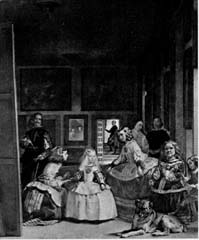
Figure 2
..
One of the morphosis explored the concept of 'betweenness' (figures 3,4, & 5) referring specifically to the relationship of artist, subject and viewer (audience). The key element of transformation was the plane of the canvas as mirror or lens. The final stage presents an understanding of the painting that challenges the initial reading of the work, thus suggesting that first encounters need to be carefully evaluated and perhaps discarded. In addition, students realized the active nature of making and the participatory role of the audience.
..
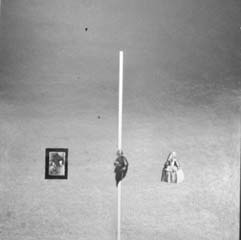
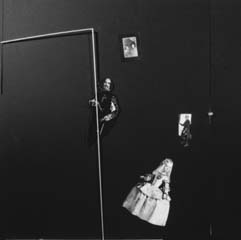
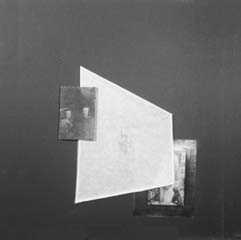
Figures 3, 4, and 5
..
A second group of students investigated the axis that the canvas denies (depth) by first using the screen (i.e., canvas) to establish a before and an after and then escorting the audience beyond the plane of the canvas into a suggestion of architectural space. Light and darkness were carefully studied and re-interpreted. Students learned how to use their intuitive curiosity as an engine to move to a different world. Architecture is presented not as a destination but as a conduit to continue their interpretive journey.
..
..
Man and Child
The work that this painting generated provided great opportunities to reflect on the nature of architectural representation (figure 6). Attention was paid to (1) how media, technique and composition were used to advance a particular conceptual agenda related to space-time; (2) the necessary act of abstraction required to construct and/or actualize the pictorial space; and thus (3) how architectural and art depictions are universes of discourse within which certain messages may be selectively conveyed (the medium is the message).
..

Figure 6
..
The students translated Bacon's shapes into an architectural syntax utilizing orthographic conventions (plan, section and elevation) to guide and push their interpretation (figures 7 & 8). The morphing goes from an objective 3D analysis of the painting (i.e., depiction as explanation) to a totally new architectural composition (i.e., depiction as interpretation) (figure 9). The catalyst of this process was the students' decision to take ownership of the painting by establishing their own rules that were inspired by Bacon's conceptual agenda.
..
 ...
...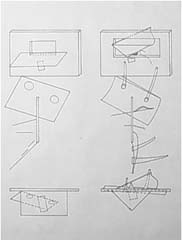 ...
...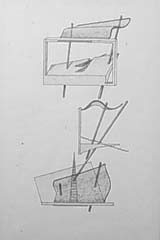
Figure 7, 8, and 9
..
..
The Fall of the Lateran
Students were overtaken by the collage quality, the use of architectural semantics, and the strong political message behind Giotto's painting (figure 10). The resolution to the project came when they moved from a traditional spatial/formal interpretation of architecture to one of architecture as politics. Students realized that the major drivers of architecture are often non-architectural forces. But just as Giotto was not merely documenting history as he was asked to do and instead critiquing it, architects can also play an important role by setting a critical dialogue with today's cultural forces.
..
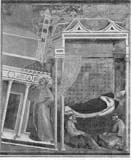
Figure 10
..
In an effort to address this, the students' morphology generates a series of parallel associations between Giotto's and today's socio-political worlds. Every symbol in the painting finds its contemporary counterpart (figures 11 through 16). Attaining consensus on the appropriate selection provoked heated discussions and awoke the whole studio to the politics of architecture, an issue that is often lost in design studios.
..
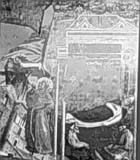 ...
...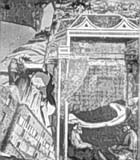 ...
...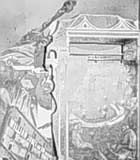
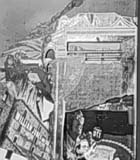 ...
...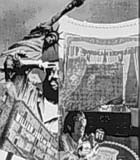 ...
...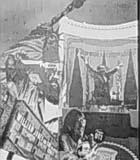
Figures 11 through 16
...
...
Silver over Black, White, Yellow, & Red
The seemingly chaotic nature of Pollock's painting (figure 17) put students in the situation of having to devise some system of interpretation to make sense of the work. The key to understand the implication of the painting was to understand the artist's methodology of making (which is factually stated in the title of the work). This meant to explore the nature, sequence and potential roles of the different layers.
...

Figure 17
...
The two projects produced in the studio incorporated Pollock's blatant methodology within their presentation. Their different outcomes were a direct result of the choices of media each team made: digital vs. graphic/physical media. Whereas the electronic production focused on the temporal unfolding of the making (i.e., a simulation of the painting process), the physical production looked at the simultaneous presence of the result (i.e., synchronic). Whereas the former was interested on the occupy able qualities of the layered space (figures 18 through 21), the later paid attention to the formal qualities of the layer itself. In other words, the digital work dealt with the experiential and the physical dealt with the conceptual aspects of the work
...
 ......
......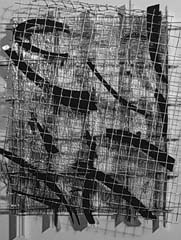
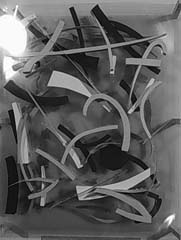
Figures 18 through 20
...
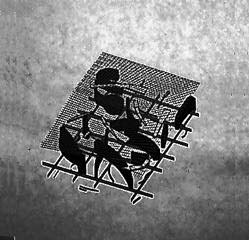
Figure 21
...
...
Conclusion
The exercise proved to be very successful at fulfilling the premises earlier stated. It generated an enormous and prolific dialogue in the studio that was contagious and exciting. The high level of production is a good indicator of how much interest and commitment this exercise drew from the students given that it was only a one week long project.
Four interpretative approaches can be cited:
This richness of interpretations showed students that architectural insight can be obtained by many different paths. It taught them a way to approach architecture that does not rely on architecture. As importantly, the exercise demonstrated to students that ideas are discovered and evolve through stages of critical inquiry and social negotiation and not in one conclusory act of explanation.
In this design studio, art was a liberation force that disabled preconceptual baggage that beginning design students bring, while preparing them to become committed interpreters and not imitators of our world.
...
...
References
[*1] Rowe, C. & R. Slutzky (1976) Transparency: Literal & Phenomenal; in C.Rowe: The Mathematics of the Ideal Villa and Other Essays. Cambridge, MA: The MIT Press, pp.159-183
[*2] Ibid. Rowe & Slutzky pay particular attention to the idea of phenomenal transparency, or the idea that figures, architectural volumes for example, are "able to interpenetrate without optical destruction of each other". This idea in its origin is from an artist, Gyorgy Kepes.
[*3] For example, S. Giedion (1941): Space, Time & Architecture. Cambridge, MA: The Harvard University Press. C. Norberg-Schulz (1975): Meaning in Western Architecture. New York: Praeger Publishers
[*4] Rockcastle, G. & M.A. Dixon-Hinson (1991). The Value of Type: A Debate. Type & the (Im)Possibilities of Convention; in Midgärd Monograph. Princeton, NJ: Princeton University Press, pp.8-9
[*5] Giedion, S. (1941): Space, Time & Architecture. Cambridge, MA: The Harvard University Press, p.432
[*6] Eadwaeard Muybridge, Animal Locomotion, Plate 169, circa 1920; in Sheldon, J.L. & Reynolds, J. (1991): Motion and Document Sequence and Time: Eadweard Muybridge and Contemporary American Photography. Andover, MA: Addison Gallery of American Art; inside back cover.
[*7] Foucault, M. (1970): The Order of Things: An Archaeology of the Human Sciences. New York, NY: Pantheon Books, pp.3-16
...